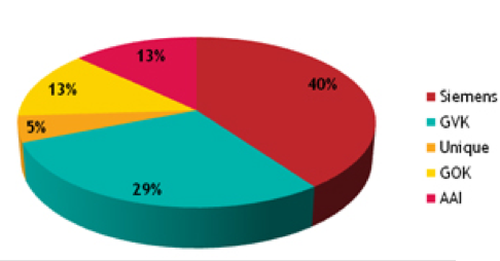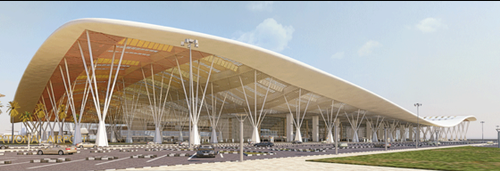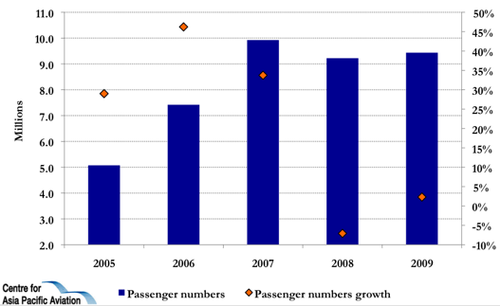Bangalore International Airport to commence Terminal 1 construction in Sep-2010
Bangalore International Airport Limited (BIAL) this month unveiled designs and details of the Terminal 1 (T1) expansion which will deliver enhanced capacity to cater to the rapidly growing passenger traffic in Bangalore.
The airport expansion, which is scheduled to commence in Sep-2010 in a three-phase process, has been designed to enhance operational performance in order to handle the expected increase in passenger traffic between now and 2015 during which period traffic is projected to grow from the current 10.6 million passengers annually to approximately 17 million passengers.
The expansion is scheduled to be completed in 18 months from the commencement of construction at an estimated cost of USD214 million. The expansion involves a 70% increase in the size of the existing terminal building to more than 130,000 sqm
Phase I will include additional security checkpoints for domestic and international departures, more seating and an exclusive lounge area within the current terminal. Phase II (expected to be complete in 18 months) will expand T1 capacity by 70%, while Phase III involves the construction of Terminal 2, which will commence in the next four to eight years, with the project to expand the airport's capacity to 36 million passengers.
Bangalore International Airport Limited Terminal 1 construction details
|
Construction |
Further detail |
|---|---|
|
Timeframe |
To commence in Sep-2010 and take 18 months to complete (for Phase II) |
|
Estimated cost |
USD217 million |
|
Capacity expansion |
The expansion of the existing T1 has been designed to enhance the operational performance in order to handle the increase of passenger traffic between now and 2015. The traffic is estimated to increase from the current 10.6 million passengers p/a to approximately 17 million passengers. The airport handled 11.6 million passenger in the previous 12 months, with the increased capacity to suffice until 2014. |
|
Area |
The expanded T1 will be spread over an area of approximately 134,000 sqm (up from the existing floor area of 72,000 sqm) |
|
Financing details |
The debt-equity ratio for the expansion project is 70:30, with funding to come "partly come from internal accruals and also from the equity holders", with the airport adding that "banks have already agreed to fund the project" |
|
Design |
Designed by HOK, along with several leading international architects, planners, urban designers, landscape architects & engineering consultants , the expanded T1 has an architectural concept based on the idea of a dramatic swooping and curving roof, under which the building sits. The roof is the unifying element for new and existing facilities. It also forms a canopy to the main entrance, offering passengers and public a giant covered area, protected from the weather |
|
Other features |
The new terminal will increase the number of check-in counters from 53 to 83, with the number of baggage reclaim belts to be increased from nine to 13 and the number of seats to increase from 2,300 to 5,300. Meanwhile, the number of boarding gates will increase from 12 (eight Code C and four Code E) to 23 (15 Code C, seven Code E and one Code F) |
Announcing the expansion, GVK commented that the project is part of efforts to make the airport the "gateway to South India", with BIAL MD, Sanjay Reddy, adding: "The expansion of the existing terminal marks a significant milestone for Bengaluru International Airport and is a step towards giving the city of Bangalore an airport that caters to its global aspirations."
Bangalore International Airport Limited Terminal 1 design
GVK interested in acquiring Siemens shares in Bangalore International
Also this month, GVK Chairman and MD, GV Krishna Reddy, expressed optimism about further increasing the company's stake in Bangalore International Airport in Jun-2011, when the three-year lock-in period for majority partner, Siemens Project Ventures, is partially lifted.
GVK has a 29% stake in the airport and is the second largest investor there. Mr Reddy commented: "We are interested in picking up a stake. But they have to offer it". Mr Reddy added that the first opportunity to acquire 14% of Siemens' 40% stake would occur in 2011 and GVK will have the first right of refusal if Siemens is seeking to sell. Siemens can then, in Jun-2015, fully exit the project, when the lock-in for the remaining 26% ends. This is based on the shareholders' agreement signed among the original five promoters of the airport in Jan-2002.
BIAL is a Public Limited Company, with the main private promoters being Siemens Project Ventures GmbH (40%), Mumbai Airport Developers Private Limited (a wholly owned subsidiary of GVK Power & Infrastructure Limited) (29%) and Flughafen Zurich (5%), with Karnataka State Industrial Investment & Development Corporation Limited (33%) and Airports Authority of India (13%) being the major state promoters.
Bangalore Airport shareholding structure

1 million passengers in May-2010
The airport, meanwhile, reported it handled 1 million passengers in May-2010. The airport handled 9.4 million passengers in 2009, a 2.3% year-on-year increase, with passenger levels increasing 86% from 2005 levels.
Domestic traffic posted year-on-year declines in the 14 months between May-2008 and Jun-2009, although international traffic remained in positive territory throughout the period.
Bangalore International Airport passenger traffic: 2005 to 2009
Increasing access options to Bangalore
Meanwhile, the high-speed rail project, which will link the airport to the central area of Bangalore (Mahatma Gandhi Road), by an approximately 35 km rail line, was tentatively cleared by an Empowered Committee of the Union Government in Aug-2010. Karnataka Government has now submitted the Detailed Project Report, the Request for Proposal, draft of the Concession Agreement and other necessary documents for formal clearance.
The estimated cost of the project is USD1.4 billion, with the government expected to provide approximately 20% of the funds. India's Civil Aviation Ministry, however, rejected Karnataka Government's request for equity participation by the Central Government in the proposed high-speed rail. The request was rejected due to Airport Authority of India's other financial commitments.
Meanwhile, National Highways Authority of India this month commenced upgrade work on the four-lane highway to Bangalore International Airport, with the road to be upgraded to a six-lane expressway by 2013. The road will be upgraded at a cost of USD149 million on a build-operate-transfer (BOT) basis. The project has been given to Navayuga Engineering Co Ltd, with initial upgrades to be completed in two years.
BIAL will not review user development fee until 2011
BIAL in May-2010 announced the Indian Airports Economic Regulatory Authority would not revise the user development fee levied at Bangalore International Airport until 2011, with the UDF fixed for three years. The airport collects INR260 (USD5.55) per domestic departing passenger and INR1,000 (USD22.85) for international services.
Commences work on real estate development
Separately, BIAL commenced work on its real estate development in May-2010, as part of efforts to raise non-aeronautical revenues to the 60:40 ratio (in favour of non-aeronautical income). The plan would be implemented in 2011 and cover 515 acres of real estate near the airport for MRO facilities, a cargo and logistics centre, hotel and conference centre.
A bit of background
Bangalore International Airport Limited (BIAL), the owner and operator of the new Bengaluru International Airport, is a public limited company, registered under the Indian Companies Act. The company is a public-private venture, which will operate the airport for the next 30 years, with an option to continue for another 30 years.
Bangalore International Airport is located 40 km North of Bangalore's CBD, and serves the "IT capital" of India. The airport is spread over an area of approximately 4000 acres and besides airport services will offer a hotel, shopping mall, food courts and other convenience amenities in the upcoming project phases.
Bangalore International Airport Key Facts
|
|
Key details |
||||||||||||||||||||||||||||||||||||||||||||||||||||||||||||||||||
|---|---|---|---|---|---|---|---|---|---|---|---|---|---|---|---|---|---|---|---|---|---|---|---|---|---|---|---|---|---|---|---|---|---|---|---|---|---|---|---|---|---|---|---|---|---|---|---|---|---|---|---|---|---|---|---|---|---|---|---|---|---|---|---|---|---|---|---|
|
Launch |
24-May-2010 |
||||||||||||||||||||||||||||||||||||||||||||||||||||||||||||||||||
|
Operational |
24 hours per day, 365 days per year |
||||||||||||||||||||||||||||||||||||||||||||||||||||||||||||||||||
|
Land area |
Approximately 4,000 acres |
||||||||||||||||||||||||||||||||||||||||||||||||||||||||||||||||||
|
Employees |
Over 5000 employees are currently employed at the airport, including BIAL and concessionaire employees |
||||||||||||||||||||||||||||||||||||||||||||||||||||||||||||||||||
|
Weekly flights |
1,100 flights (international and domestic) operate from Bangalore International Airport every week on an average |
||||||||||||||||||||||||||||||||||||||||||||||||||||||||||||||||||
|
Terminal details |
Built on a footprint of eight acres, the terminal building is spread over 71,000 sqm, with peak hour capacity of approximately 3,000 passengers. The airport has 20 boarding gates (including eight aerobridges and nine bays) |
||||||||||||||||||||||||||||||||||||||||||||||||||||||||||||||||||
|
Other facilities |
|
||||||||||||||||||||||||||||||||||||||||||||||||||||||||||||||||||
|
Runway details |
4,000m x 45m (60m including light paved shoulder) runway (Runway orientation 09/27). The airport has two high speed exit taxiways |
||||||||||||||||||||||||||||||||||||||||||||||||||||||||||||||||||
|
Passenger airlines |
Recent route changes at Bangalore International Airport
|
||||||||||||||||||||||||||||||||||||||||||||||||||||||||||||||||||
|
Cargo warehouse |
A dedicated bay in the terminal apron is earmarked for freight aircraft. Cargo warehouses have the capacity to handle approximately 350,000 tonnes of cargo p/a |
||||||||||||||||||||||||||||||||||||||||||||||||||||||||||||||||||
|
Freight operators |
|

